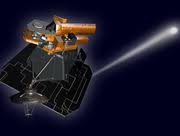

It’s Cold and Wet at The Moon’s South Pole
Frozen water just inches below the Moon’s surface has been confirmed by an international team of scientists.
Based on data the group obtained with an instrument aboard the Lunar Reconnaissance Orbiter, or LRO, NASA chose the impact site for the LCROSS probe, which slammed into the Moon’s surface last year in October in an attempt to kick up dust that could be analyzed for the presence of water ice.
“We found significant amounts of water around the north and south poles, in places where previously we were only tentatively thinking of it,” said University of Arizona professor William Boynton.
In addition to confirming water and its distribution in unprecedented detail, the data included an unexpected finding.
“To our surprise, some of the permanently shadowed regions had no water, but some of the areas that receive sunlight occasionally did have water,” Boynton said.
In other words, water was found not only where it is supposed to be, but also where it is not supposed to be.
Previously, scientists were convinced water ice could only persist in so-called Permanently Shadowed Regions, or PSRs—places on the Moon’s surface where the Sun never reaches. Unlike Earth, whose tilted axis ensures that any spot on the surface receives sunlight at some point during our year-long journey around the Sun, the Moon’s axis is hardly tilted at all. As a result, some places on the lunar surface are never exposed to sunlight.
“In some of the craters that are close to the north or south pole and have very steep walls, no direct sunlight ever reaches the bottom of the crater,” Boynton said.
“At down to minus 370 degrees Fahrenheit, those PSRs are colder than Pluto,” added Karl Harshman, a software engineer with UA’s Lunar and Planetary Lab.
But according to the measurements the group obtained using the Lunar Exploration Neutron Detector, or LEND, aboard the LRO spacecraft orbiting the Moon, there is water even in areas that are exposed to the Sun’s warming rays every once in a while.
To trace the abundance of water on the Moon, the scientists took advantage of cosmic particles constantly bombarding every object in space. Since the Moon lacks a protective atmosphere, the particles strike the surface at close to the speed of light. When they collide with the atomic nuclei in the dusty soil, they knock particles off these atoms, mostly protons and neutrons, some of which escape into space. If one of these particles hits a hydrogen atom, which is most likely part of a water molecule, it slows down dramatically, leaving fewer particles fast enough to escape to space.
By measuring differences in the flow of neutrons coming from different places on the Moon’s surface, the researchers were able to infer the amount of water present in the soil: Areas emitting low neutron radiation indicated that water was capturing and retaining most of the neutrons, while areas reflecting high neutron radiation identified themselves as dry.
In the PSRs near the LCROSS impact site at the Moon’s south pole, the soil was found to contain up to four percent water.
“The water might be like some form of ice mixed with the soil, possibly similar to the slightly damp, frozen soil found in Alaska,” Boynton said. “We think that in the PSRs, water ice might be present on the surface, but the fact we found it in the partially sunlit areas, too, means the upper three inches or so must be dry dirt; otherwise the sunlight would cause the water to evaporate.”
Possible origins of the water on the Moon include impacts of icy comets or hydrogen deposited from solar wind, the authors noted.
The study was led by Igor Mitrofanov at the Institute for Space Research of the Russian Academy of Science in Moscow, the agency that supplied the LEND instrument used in this study. LRO is managed by NASA’s Goddard Space Flight Center in Greenbelt, Md.
You can contact Bob Eklund at [email protected], or visit his website at www.bobeklund.com.





Be the first to comment